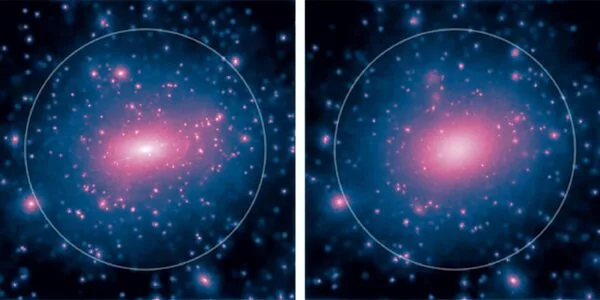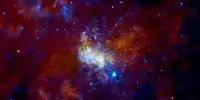A new study suggests the existence of direct interaction between the elementary particles that make up the dark matter halo and those that make up ordinary matter, which contradicts the current prevailing theory used to describe the universe.
A vast spherical region made up of dark matter particles exists at the center of spiral galaxies, both close to us and billions of light-years away. This region is distinguished by two features: a constant density out to a certain radius that miraculously expands over time, while the density decreases.
This implies the existence of direct interaction between the elementary particles that comprise the dark matter halo and those that comprise ordinary matter — protons, electrons, neutrons, and photons. We anticipate that this hypothesis will be in direct conflict with the current prevailing theory used to describe the universe, known as Lambda-Cold Dark Matter, which holds that particles of cold dark matter are inert and do not interact with any other particle except gravitationally.
These important findings have been reported in a new study, recently published in the prestigious Astronomy and Astrophysics journal, that studied a large number of distant galaxies, some seven billion light-years away. The study, conducted by Gauri Sharma and Paolo Salucci from SISSA, together with Glen Van de Ven from the University of Vienna, took a new look at one of the greatest mysteries of modern physics.
By studying the movement of stars in approximately 300 distant galaxies, we discovered that these objects also had a halo of dark matter, and that, by starting out from the centre of a galaxy, this halo effectively has a region in which its density is constant.
Paolo Salucci
According to the authors, this new study advances our understanding of dark matter, an elusive element in our universe that has been theorized based on its demonstrable effects on celestial bodies but has yet to be directly proven. This is despite a plethora of targeted astrophysical observations and experiments set up in dedicated underground laboratories for the purpose.
Studying dark matter in distant galaxies
According to Gauri Sharma, dark matter accounts for approximately 84 percent of the mass in the universe. “Its dominant presence throughout the galaxies arises from the fact that the stars and hydrogen gas move as if governed by an invisible element.” Until now, attempts to study it have concentrated on galaxies close to our own: “In this study, however,” she explains, “we were seeking to observe and determine the distribution of the mass of spiral galaxies with the same morphology as those nearby, but much further away and thus seven billion years earlier. The idea is essentially that these progenitors of spiral galaxies like our own could offer fundamental clues into the nature of the particle at the heart of the mystery of dark matter.”
Paolo Salucci adds: “By studying the movement of stars in approximately 300 distant galaxies, we discovered that these objects also had a halo of dark matter, and that, by starting out from the centre of a galaxy, this halo effectively has a region in which its density is constant.” This trait had already been observed in studies examining nearby galaxies, some of which were also the work of SISSA.

However, new research has revealed that this central region contained something completely unexpected in the context of the so-called “standard model of cosmology.” According to Sharma, “we could see that not only is there an unexplained region with a constant density of dark matter, but also that its dimensions increase over time as if subjected to a process of ongoing expansion and dilution as a result of the contrast between the properties of nearby and distant spiral galaxies — that is, between today’s galaxies and their forefathers from seven billion years earlier.”
This evidence is very difficult to be explained if the dark matter particles did not interact, as posited in the Lambda-CDM model. “In the research we recently published,” says Sharma, “we offer evidence of direct interaction between dark matter and ordinary matter, that over time slowly builds up a region of consistent density from the centre of the galaxy outwards.” But there’s more.
A slow yet inexorable process
“Amazingly, the above region with constant density expands over time. It’s a very slow process, but one that is inexorable” states Salucci. One possible explanation? “The simplest is that, in the beginning, when the galaxy was formed, the distribution of dark matter in the spherical halo was as predicted by the Lambda-CDM theory, with a density peak in the centre. Later on, the galactic disc that characterises spiral galaxies is formed, surrounded by a halo of extremely dense dark matter particles. As time passed, the effect of the interaction that we have posited meant that the particles were captured by the stars or expelled into the outer reaches of the galaxy.”
As described in the article in “Astronomy and Astrophysics,” this process would create a spherical region of consistent density within the dark matter halo, with dimensions that increase proportionally over time and eventually reach those of the galactic stellar disc. “The study’s findings raise important questions for alternative scenarios that describe dark matter particles (other than Lambda-CDM), such as Warm Dark Matter, Self-Interacting Dark Matter, and Ultra Light Dark Matter,” Sharma says.
“These models must also take into account the above region’s clear time evolution. The properties of very distant galaxies in space and time provide cosmologists with a genuine gateway to understanding the mysteries of dark matter.”
It is worth noting that “the truth of this mystery may be revealed not by detailing the most beautiful scenario — the one that is mathematically most elegant, simple, and anticipated as an expansion of long-verified theories — but rather through a “ugly” scenario determined by an inelegant and complicated observational phenomenology, from a neglected physical theory that is completely unrelated to that which is familiar to us.”














